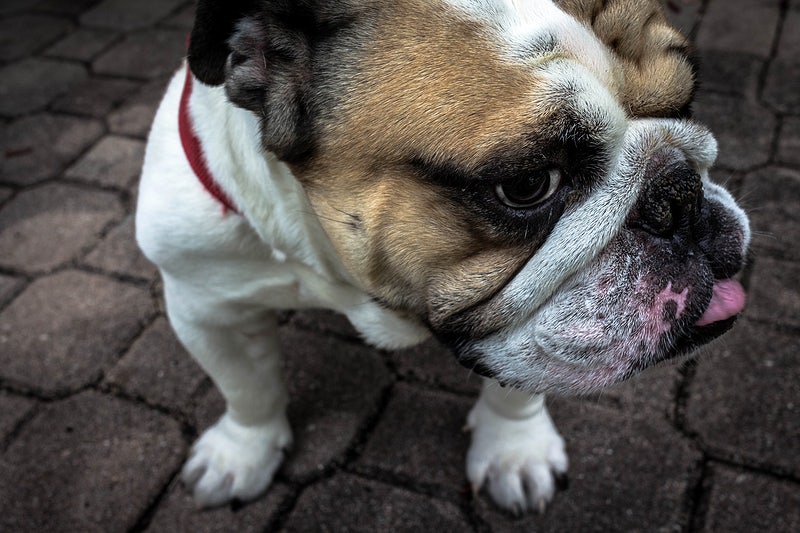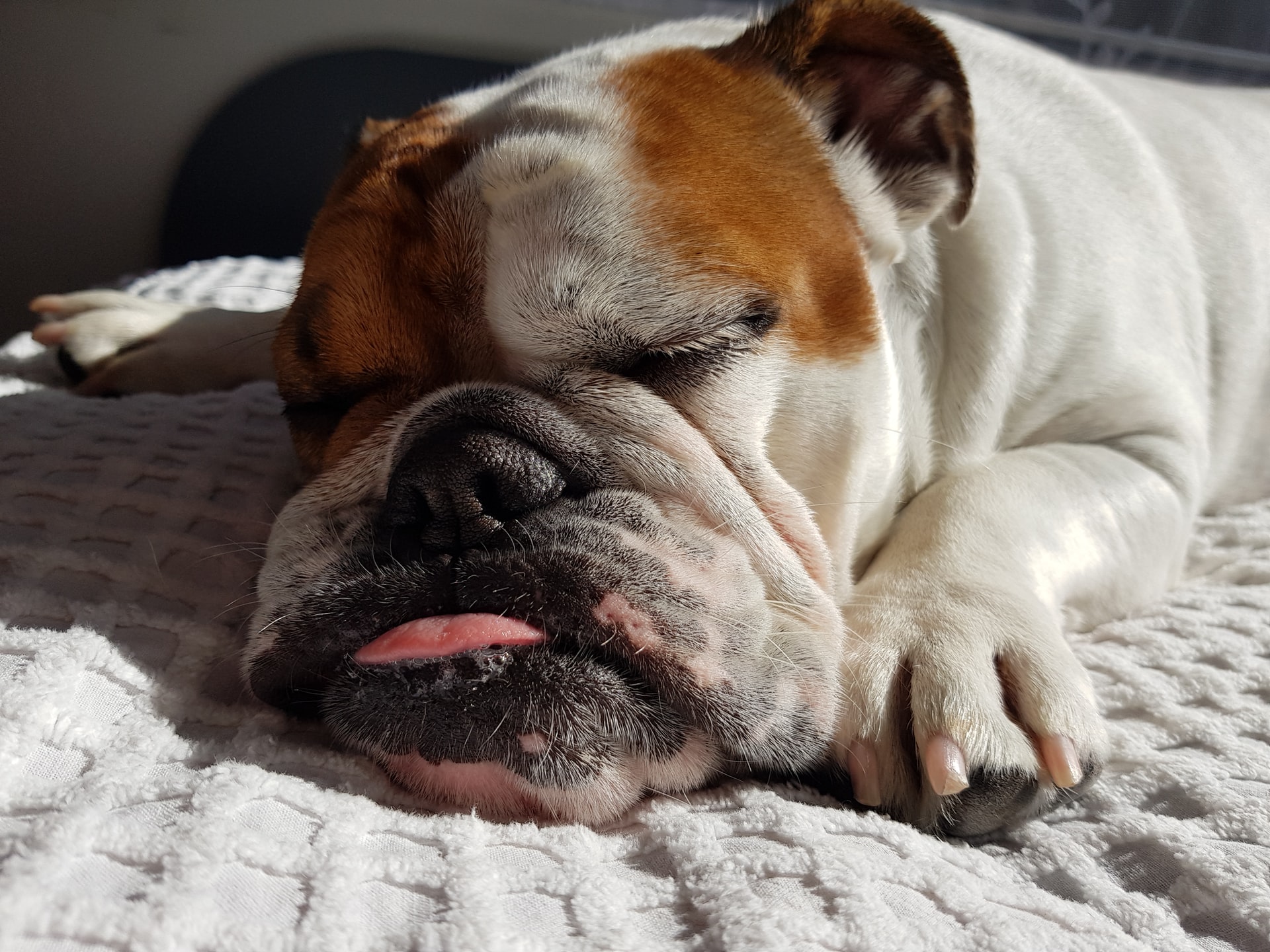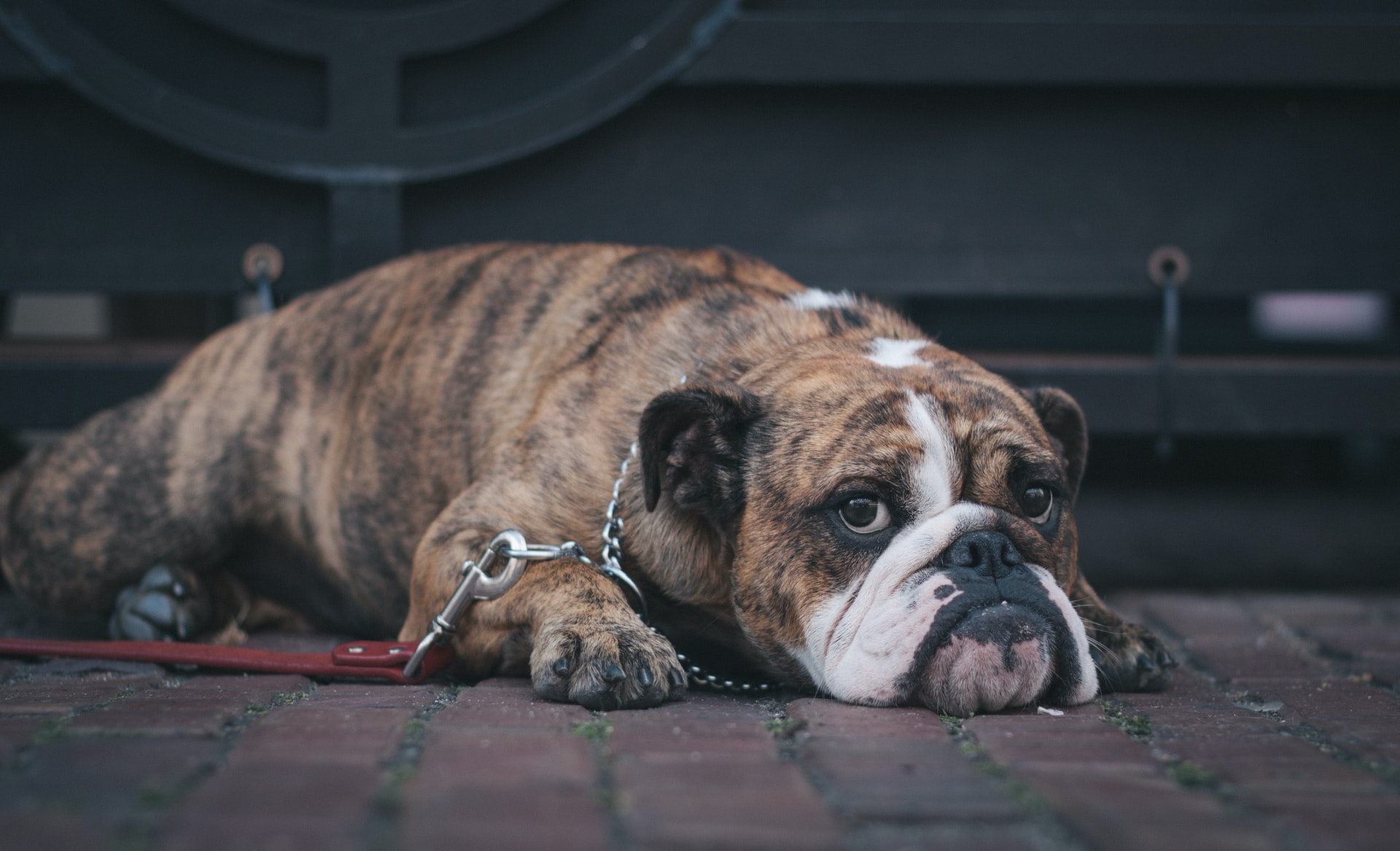Localized swelling is common among dogs, especially in the facial area. With this, many pet owners are left asking, why is my dog’s face swollen on one side?
There are many possible reasons why swelling happens in dogs. Still, there’s one common denominator: swelling indicates a problem. If one or both sides of your dog’s face is swelling, you have to consult the vet as soon as possible.
Below, we discuss the possible reasons why one side of your dog’s face is swollen. Again, these are just general pointers and it doesn’t replace the expertise of a licensed veterinarian.
Why is my dog’s face swollen?
1. Insect sting

The most common reason why one side of a dog’s face will swell is an insect sting or bite. Canines are curious beings and they will try to befriend a bee. Unfortunately, such an attempt could end up in a nasty bite that could swell for days.
An insect bite on your dog’s face will swell, become hot to touch, and reddish. It will swell dramatically to the point that one side of your pet’s face appears abnormally enlarged.
Depending on the sensitivity of your dog, most cases of insect bites aren’t life-threatening. It can go away on its own without medication, but it’s still best to provide first aid to speed up your pet’s recovery.
However, some dogs may develop an adverse reaction to insect bites called anaphylactic shock. This is characterized by swelling on the bitten area, hives, vomiting, drooling, and diarrhea. It’s a life-threatening reaction that requires immediate veterinary attention.
How to deal with insect stings in dogs
If your dog got an insect sting, you should check for the stinger right away. This is the body part of the insect that gets stuck on the bitten area. It’s important to remove the stinger carefully, so it won’t eject more venom into your canine’s body.
Contrary to common practice, you should never use a tweezer in removing the stinger. Doing so will just squeeze the stinger and release the venom. Instead, you should use a credit card or similar material to pull the stinger out.
After that, put a cold compress on the side of your dog’s face that’s been bitten by the insect. This will help soothe the pain and prevent further swelling.
If your dog doesn’t exhibit adverse reactions, you can simply treat the bite area with a paste made of water and baking soda. An oatmeal bath will also help if your dog has been bitten in other areas as well.
2. External trauma

Another possible reason why one side of your dog’s face swells is external trauma. It’s possible that your pooch got hit by an oncoming car, a blunt object, or has experienced a bad fall.
Due to the impact, your dog’s face will start to buildup fluids in the affected area. Take note that external trauma doesn’t need an open wound to make one side of your dog’s face swell.
Remember that the problem here isn’t the swelling alone. External trauma can cause severe damage to your dog’s face. Underneath the swelling, there could be fractures, internal bleeding, and other injuries that require veterinary attention.
If left untreated, external trauma in a dog’s face may trigger infections and a slew of other health problems. Also, you have to consider the possibility that your dog has other injuries on other parts of the body if it’s been hit by a car or repeatedly whipped by someone.
How to deal with external trauma in dogs
If you suspect that your dog has injuries due to external trauma, the best way to deal with it is to bring the dog to the vet. This way, your pooch will be examined properly and treated according to the diagnosis.
It’s important to bring your dog to the vet as soon as the trauma or injury occurred. The faster your dog gets treated, the lesser the damage will be. It will also save you from expensive treatments later on.
Take note that it’s not a good idea to self-medicate external trauma on dogs at home. While you may see initial progress, your pet will eventually succumb to the injury.
3. Dental problems

If one side of your dog’s face is swollen, you should check for potential dental problems. One of the common culprits here is tooth decay.
Rotten teeth, when infected, will cause the gums to swell and develop an abscess. On the outside, it will appear as if one side of your pet’s face is unusually larger.
Aside from rotten teeth, gum problems can also make your dog’s face swell. If not treated right away, gum problems can lead to full-fledged gum disease and infection.
In younger canines, retained puppy teeth can also make one side of the face swell. Normally, a pup will shed all its milk teeth up to six months of age. If any remains intact, it has to be removed at the vet’s clinic. If not, the adult set of dog teeth will get crowded and trigger a massive dental problem.
Also, canine dental problems can be the root cause of heart problems. It’s because open wounds in the mouth are easy entryways for various pathogens.
Besides swelling of the face, dogs with dental problems will also experience bad breath, reluctance to eat, pain or whining while chewing, and blood-stained saliva.
How to deal with dental problems in dogs
Dental problems in dogs should be addressed as it occurs. This way, the infection won’t spread, which will be harder to treat.
Depending on the specific condition of your pet, the veterinarian will come up with a treatment plan. Rotten teeth have to be extracted and abscesses drained. For dogs with gum disease, a longer treatment is necessary to curb the infection.
After your dog’s dental problem has been treated, prevention should be the next course of action. This is part of keeping your pet’s dental health and avoiding any swelling in its facial area.
4. Tumors

Tumors may appear as swelling on the side of your dog’s face, but instead of subsiding, it only gets larger as time goes by.
In dogs, tumors often occur on the mouth, throat, and behind the eyes. This may appear as if one side of your pet’s face is swelling. But unlike localized inflammation, tumors don’t usually become reddish or hot to touch. Instead, it feels like a lump that’s part of your dog’s body.
Moreover, facial tumors in dogs can either be cancerous or non-cancerous. Regardless, your dog should be brought to the veterinarian for proper diagnosis and treatment.
In case your dog’s facial tumor is cancerous, early detection is crucial. This is to prevent the spread of cancer cells to other parts of your dog’s body. It will also make treatments much easier and less costly on the part of the pet owner.
How to deal with tumors in dogs
Tumors in dogs need veterinary attention for proper diagnosis. The first step is to identify whether the tumor is cancerous or not through a biopsy. Based on the result of this test, the vet will perform different treatment methods.
For cancerous facial tumors, your dog will undergo surgery to remove the abnormal growth. Depending on how widespread the problem is, your pet may also need radiotherapy to kill any remaining cancer cells. Aside from that, various medications are also necessary to ensure that your pet will have a positive prognosis.
As for non-cancerous facial tumors in canines, a surgical procedure to remove the mass is also necessary. But since it’s not malignant, radiotherapy won’t be necessary. Usually, the veterinarian will prescribe antibiotics and other after-care medications for your pet’s recovery.
5. Allergies

On a less serious note, allergies might be the reason why one side of your dog’s face is swollen.
Food allergy is the most common in dogs. While it causes swelling, it usually happens throughout the body and not just on one side of the face.
On the other hand, environmental allergies can cause swelling in just one side of your pet’s face. This can happen if your pet had physical contact with an allergen. Aside from swelling, your dog will also develop hives in the affected area. In worst cases, your pet will succumb to anaphylactic shock.
Take note that swelling is just one of the symptoms of allergy in canines. The bigger problem is how allergies take a serious toll on your pet’s health.
How to deal with allergies in dogs
There’s really no absolute cure for allergies in dogs. The only thing you can do is manage it by avoiding your pet’s triggers or the allergens that cause the adverse reactions.
Also, it’s important to remember that dogs can develop allergic reactions at any point in their lives. So just because your pet isn’t allergic to a substance right now doesn’t mean it will be the same all the time.
Despite that, the vet is your friend in managing your canine’s allergies. Your dog’s veterinarian can recommend antihistamines that will help reduce facial swelling and other symptoms. Above all, the vet can identify your dog’s triggers through a comprehensive allergy test.
6. Swelling of the salivary gland

If your dog doesn’t have dental problems or external injuries, the issue could be on the salivary glands. Swollen salivary glands can cause swelling on one or both sides of a canine’s face.
This problem can be due to external trauma, bite wounds, choke collars, stuck foreign matter, infection, and more. Sialocele or accumulation of saliva within the tissue can also be the culprit behind your pet’s swollen face.
To confirm whether your dog’s facial swelling is due to salivary gland problems, your dog’s vet will conduct blood chemistry and an X-ray exam.
A cytology exam can also be done by extracting a sample of the swollen area using a fine needle. This sample will be placed under the microscope to check whether there’s an abnormality that could point to salivary gland issues.
Take note that the swelling of the salivary glands can make it hard for your dog to swallow. Some dogs will also experience breathing difficulties as well as protrusion of the eyes once the swelling is severe.
How to deal with swollen salivary glands in dogs
If your dog has swelling salivary glands, the vet is the best person to consult. Usually, the treatment is to remove the affected tissue if the swelling of your dog’s face is due to a sialocele.
Other surgical procedures can also be done to address the swelling of your dog’s salivary glands, especially if it’s not subsiding.
On the other hand, salivary gland swelling that’s due to trauma can be treated through the management of the injury. If the cause is choke collars, stopping the usage of such accessories can help your dog recover.
7. Lymphatic obstruction

Lymphatic obstruction is also a common reason why one side of your dog’s face may become swollen. What happens is that fluids accumulate in one spot of the canine’s body, specifically the face. It’s also called lymphedema.
Aside from the face, your dog may also have lymphedema in the legs and other parts of its body. If not addressed, lymphedema can branch out into a serious illness.
Take note that lymphatic obstruction can also be a secondary condition to other illnesses. This is why you should get your dog checked right away to prevent the possibility of life-threatening circumstances.
Dogs suffering from lymphatic obstruction will also experience pain in the affected area, skin discoloration on the affected area, and delayed healing.
How to deal with lymphatic obstruction in dogs
If you suspect that your dog has a lymphatic obstruction, you should bring it to the vet right away. You should know that lymphedema isn’t a curable condition, so the best thing you can do is manage the symptoms.
Depending on your dog’s condition, the vet may prescribe certain medications. Massaging the swelling on your dog’s face will also help drain the fluids.
If there are secondary infections, the vet can prescribe antibiotics to clear them up. If the fluid accumulation on the side of your dog’s face doesn’t drain through external means, the vet may recommend a surgical operation.
You can also use pressure wraps to help prevent fluid accumulation. Therapy sessions may also be required if you’re bent on not subjecting your pet to invasive operations.
8. Craniomandibular osteopathy

Craniomandibular osteopathy in dogs is a condition that affects a canine’s head and jaw. It can make one side of your pet’s face swollen. Aside from that, dogs with this problem will also experience excessive salivation, pain when opening the jaw, and poor appetite.
While any dog can develop craniomandibular osteopathy, small breeds are at a higher risk. The likes of Cairn Terrier, Bull Terrier, Scottish Terrier, and Boston Terriers have a higher risk of developing this problem.
Nevertheless, this condition is considered to be uncommon. But if your pooch has a swollen but the first seven reasons have been cleared, you should have it checked for craniomandibular osteopathy instead.
How to deal with craniomandibular osteopathy in dogs
If your dog has been diagnosed with craniomandibular osteopathy, the focus would be on managing the pain your dog suffers from.
Depending on the severity of the condition, the vet may prescribe non-steroidal anti-inflammatory drugs (NSAIDs), corticosteroids, and antibiotics if there’s an infection.
The good news is that most dogs with craniomandibular osteopathy will usually outgrow it, especially if it surfaced at a young age. But for worse cases, veterinary intervention is extremely necessary.
There’s no specific way to prevent this on your dog. The best way to stop the spread of the faulty gene is to spay affected canines, so they won’t produce more offspring.
How to reduce your dog’s risk of inflammation
While there are many possible reasons why one side of your dog’s face will swell, reducing its inflammatory risks can help a lot. The following are some of the steps you can take:
🐶Feed a suitable diet
Raising a healthy dog starts by feeding the right diet. Avoid giving your dog a high-calorie diet as it stimulates immune cells in fat tissues. This directly results in increased inflammation, not to mention that it will also make your pet likely to develop obesity.
Also, you should consult your dog’s veterinarian about the best formula that suits your pet’s needs. Remember that there’s no one-size-fits-all when it comes to a canine’s diet.
In general, dogs eating a high-protein and low-carb diet have lower inflammatory tendencies and they also experience better digestion.
🐶Consult your dog’s veterinarian
Even if your dog looks healthy, visiting and consulting a veterinarian is still necessary. This way, your pooch will be checked for potential health problems.
Aside from that, your pet’s veterinarian can check whether your dog has inflammatory illnesses. If so, the vet can provide immediate treatments to prevent the problem from worsening.
🐶Keep your dog active
The lack of physical activity will make your dog prone to lymphatic problems. This is why you should keep your pet active through ample exercise that matches its breed.
It’s recommendable to come up with an exercise routine to ensure that your pet gets the physical stimulation it badly needs.
Frequently Asked Questions
Q: How long does it take for a dog’s swollen face to subside?
A: The duration of inflammation on a dog’s face depends on the root cause. For example, if it’s due to a bee sting, it would likely go away within hours. However, if your dog is dealing with a tumor, it won’t go away until your pet receives the proper veterinary intervention. Overall, you should never dismiss facial swelling on your dog even if it looks harmless on the surface.
Q: Can I give Benadryl to my dog if its face is swelling?
A: You can give Benadryl to your dog if the cause of facial swelling is an allergic reaction. If not, Benadryl may not be effective as means of treatment. Instead, you should call your dog’s veterinarian, so your pet will be examined, diagnosed, and treated properly. Remember, facial swelling in dogs can be as simple as an insect sting or as serious as cancer.
Q: Will my dog’s swollen face heal on its own?
A: Swelling always indicates that there’s a problem with a dog’s body. While some cases of facial swelling will subside without treatment, others would worsen by the day. This is why you should get your dog checked. Being proactive in these situations will save your pet from suffering and your pocket from dealing with a hefty vet bill later on.
Q: Can a dog die from swelling?
A: Swelling is a symptom of an underlying problem. Such a problem can be mild or serious. If your pet has a swollen face due to a cancerous tumor, there’s a life-threatening risk, especially if it’s not treated right away. In the end, the severity of the swelling depends on what’s causing it in the first place.
Q: Can I treat my dog’s swollen face at home?
A: It’s possible to treat your dog’s swollen face at home after consulting the veterinarian. The vet can prescribe home remedies as long as the swelling is due to mild causes like insect stings or minor allergic reactions. Other than that, your dog will likely need a more serious veterinary intervention.
Final words
Why is my dog’s face swollen on one side? It could be anywhere from insect stings, external trauma, tumor allergies, and more. The best thing to do is consult the vet to get your pet diagnosed properly. It will also let your dog be treated immediately.
Being proactive when it comes to your dog’s health will pay off in the end. So once you’re noticing symptoms of a potential health problem, you should consult the vet as soon as possible. This applies not just to your dog’s face, but also its entire body.
Have you encountered this problem with your dog before? How did you handle it? Share your thoughts in the comment section below!


I have a #80 lab, Jerzy is approximately12 or 13 and her nose is swelling up every day off and on but only on the left side. It gets hard and about as big as a grape and then it goes away. Her liver #’s are up, so she can’t be sedated. She originally went it to have tumors on her eye lid removed, which had to be canceled. Nobody seems to have any idea what it could be. Any one here have any ideas at all? It doesn’t seem to bother her but her breathing is pretty rapid a lot and then sometimes really shallow. If anybody has experienced this please please reply. My email is [email protected] TIA Sincerly, Tammy and my baby girl Jerzy